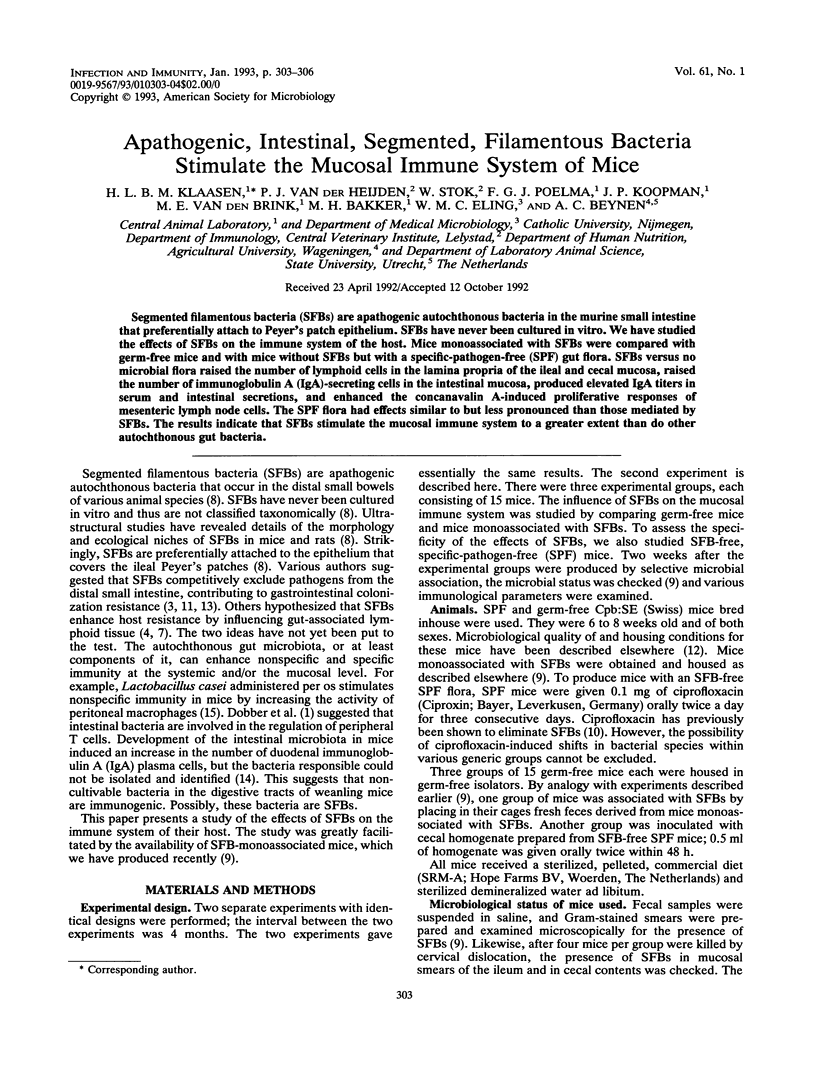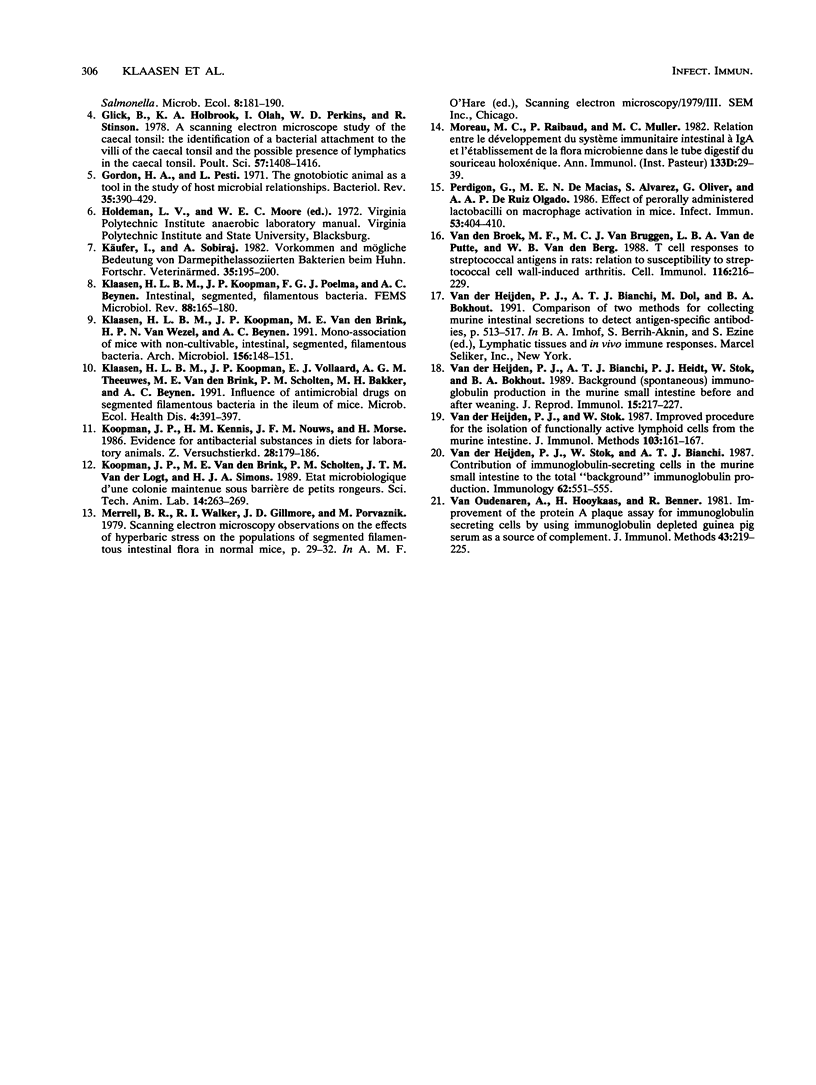Abstract
Segmented filamentous bacteria (SFBs) are apathogenic autochthonous bacteria in the murine small intestine that preferentially attach to Peyer's patch epithelium. SFBs have never been cultured in vitro. We have studied the effects of SFBs on the immune system of the host. Mice monoassociated with SFBs were compared with germ-free mice and with mice without SFBs but with a specific-pathogen-free (SPF) gut flora. SFBs versus no microbial flora raised the number of lymphoid cells in the lamina propria of the ileal and cecal mucosa, raised the number of immunoglobulin A (IgA)-secreting cells in the intestinal mucosa, produced elevated IgA titers in serum and intestinal secretions, and enhanced the concanavalin A-induced proliferative responses of mesenteric lymph node cells. The SPF flora had effects similar to but less pronounced than those mediated by SFBs. The results indicate that SFBs stimulate the mucosal immune system to a greater extent than do other autochthonous gut bacteria.
Full text
PDF



Selected References
These references are in PubMed. This may not be the complete list of references from this article.
- Dobber R., Hertogh-Huijbregts A., Rozing J., Bottomly K., Nagelkerken L. The involvement of the intestinal microflora in the expansion of CD4+ T cells with a naive phenotype in the periphery. Dev Immunol. 1992;2(2):141–150. doi: 10.1155/1992/57057. [DOI] [PMC free article] [PubMed] [Google Scholar]
- Eling W. M., Jerusalem C. R., Hermsen C. C., Heinen-Borries U. J., Weiss M. L., Van Run-Van Breda C. H. Endomyocardial lesion and endomyocardial fibrosis in experimental malaria (Plasmodium berghei) in mice. Contrib Microbiol Immunol. 1983;7:218–229. [PubMed] [Google Scholar]
- Glick B., Holbrook K. A., Olah I., Perkins W. D., Stinson R. A scanning electron microscope study of the caecal tonsil: the identification of a bacterial attachment to the villi of the caecal tonsil and the possible presence of lymphatics in the caecal tonsil. Poult Sci. 1978 Sep;57(5):1408–1416. doi: 10.3382/ps.0571408. [DOI] [PubMed] [Google Scholar]
- Gordon H. A., Pesti L. The gnotobiotic animal as a tool in the study of host microbial relationships. Bacteriol Rev. 1971 Dec;35(4):390–429. doi: 10.1128/br.35.4.390-429.1971. [DOI] [PMC free article] [PubMed] [Google Scholar]
- Klaasen H. L., Koopman J. P., Van den Brink M. E., Van Wezel H. P., Beynen A. C. Mono-association of mice with non-cultivable, intestinal, segmented, filamentous bacteria. Arch Microbiol. 1991;156(2):148–151. doi: 10.1007/BF00290989. [DOI] [PubMed] [Google Scholar]
- Koopman J. P., Kennis H. M., Nouws J. F., Morse H. Evidence for antibacterial substances in diets for laboratory animals. Z Versuchstierkd. 1986;28(4):179–186. [PubMed] [Google Scholar]
- Moreau M. C., Raibaud P., Muller M. C. Relation entre le développement du système immunitaire intestinal à IgA et l'établissement de la flore microbienne dans le tube digestif du souriceau holoxénique. Ann Immunol (Paris) 1982 Jul-Aug;133D(1):29–39. [PubMed] [Google Scholar]
- Perdigon G., de Macias M. E., Alvarez S., Oliver G., de Ruiz Holgado A. A. Effect of perorally administered lactobacilli on macrophage activation in mice. Infect Immun. 1986 Aug;53(2):404–410. doi: 10.1128/iai.53.2.404-410.1986. [DOI] [PMC free article] [PubMed] [Google Scholar]
- Van Oudenaren A., Hooijkaas H., Benner R. Improvement of the protein A plaque assay for immunoglobulin secreting cells by using immunoglobulin-depleted guinea pig serum as a source of complement. J Immunol Methods. 1981;43(2):219–224. doi: 10.1016/0022-1759(81)90026-0. [DOI] [PubMed] [Google Scholar]
- Van der Heijden P. J., Stok W. Improved procedure for the isolation of functionally active lymphoid cells from the murine intestine. J Immunol Methods. 1987 Nov 5;103(2):161–167. doi: 10.1016/0022-1759(87)90285-7. [DOI] [PubMed] [Google Scholar]
- van den Broek M. F., van Bruggen M. C., van de Putte L. B., van den Berg W. B. T cell responses to streptococcal antigens in rats: relation to susceptibility to streptococcal cell wall-induced arthritis. Cell Immunol. 1988 Oct 1;116(1):216–229. doi: 10.1016/0008-8749(88)90222-5. [DOI] [PubMed] [Google Scholar]
- van der Heijden P. J., Bianchi A. T., Heidt P. J., Stok W., Bokhout B. A. Background (spontaneous) immunoglobulin production in the murine small intestine before and after weaning. J Reprod Immunol. 1989 Jul;15(3):217–227. doi: 10.1016/0165-0378(89)90013-2. [DOI] [PubMed] [Google Scholar]
- van der Heijden P. J., Stok W., Bianchi A. T. Contribution of immunoglobulin-secreting cells in the murine small intestine to the total 'background' immunoglobulin production. Immunology. 1987 Dec;62(4):551–555. [PMC free article] [PubMed] [Google Scholar]


